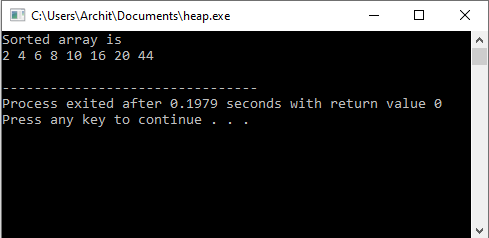C++ Heap Sort
Heapsort is executed on the structure of the heap data. We know heap is a complete tree in binary form. The heap tree can be of two different types: Min-heap, or heap max. The root element is minimal for min-heap, and maximum for a max heap. Upon forming a heap, we can remove an object from the root and transfer the last element to the root. After this procedure of swapping, we have to heap the whole array again. We can filter the entire array by removing elements from the root.
The complexity of Heap Sort Technique
- Time Complexity: O(n log n)
- Space Complexity: O(1)
Input and Output
Input:
A list of unsorted data: 50 4 11 40 32 81 70
Output:
Array before Sorting: 50 4 11 40 32 81 70
Array after Sorting: 4 11 32 40 50 70 81
Algorithm
Input: A data array, and the total number in the array
Output: Max heap using an element in an array
Begin for k := 1 to size do node := k par := floor (node / 2) while par >= 1 do if array[par] < array[node] then swap array[par] with array[node] node := par par := floor (node / 2) done done End
What is a Binary Heap?
This Binary Heap is a complete binary tree in which entities are placed in a special order, such that a parental node’s value is greater than its two nodes’ values. The former is called a heap max, while the latter a heap min. The heap can be described through an array or binary tree.
Algorithm for sorting in increasing order:-
- Create a maximum heap of the data input.
- The greatest element is placed at the root of the heap at this stage. Replace it with the last heap component, then increase the heap size by 1.
- Repeat steps above whilst heap size is greater than 1.
How to create a heap?
The heapify procedure can only be implemented to a node if it heaps its children’s nodes. Thus heapification must be carried out in the order from the bottom up.
Using an example let’s understand:
Input data: 6, 20, 2, 7, 1 6(0) / \ 20(1) 2(2) / \ 7(3) 1(4)
The numbers in bracket represent the indices in the array representation of data.
Applying the heapify procedure to index 1: 6(0) / \ 20(1) 2(2) / \ 7(3) 1(4) Applying the heapify procedure to index 0: 20(0) / \ 7(1) 2(2) / \ 6(3) 1(4) The heapify procedure calls itself recursively to build the heap in the top down manner.
Example of heap sort implementation:
// C++ program for implementation of Heap Sort
include
using namespace std;
void heapify(int arr[], int s, int k)
{
int largest = k; // Initialize largest as root
int P = 2k + 1; // left = 2k + 1
int v= 2k + 2; // right = 2k + 2
if (P < s && arr[P] > arr[largest]) largest = P; // If right child is larger than largest so far
if (v < s && arr[v] > arr[largest]) largest = v; // If largest is not root
if (largest != k)
{
swap(arr[k], arr[largest]); // Recursively heapify the affected sub-tree
heapify(arr, s, largest);
}
} // main function to do heap sort
void heapSort(int arr[], int s)
{
// Build heap (rearrange array)
for (int k = s / 2 - 1; k >= 0; k--)
heapify(arr, s, k); // One by one extract an element from heap
for (int k=s-1; k>0; k--)
{
// Move current root to end
swap(arr[0], arr[k]);
// call max heapify on the reduced heap
heapify(arr, k, 0);
}
}
/* A utility function to print array of size s */
void printArray(int arr[], int s)
{
for (int k=0; k<s; ++k)
cout << arr[k] << " ";
cout << "\n";
}
// Driver program
int main()
{
int arr[] = {20, 10, 16, 4, 8, 6, 2, 44};
int s = sizeof(arr)/sizeof(arr[0]);
heapSort(arr, s);
cout << "Sorted array is \n";
printArray(arr, s);
}
